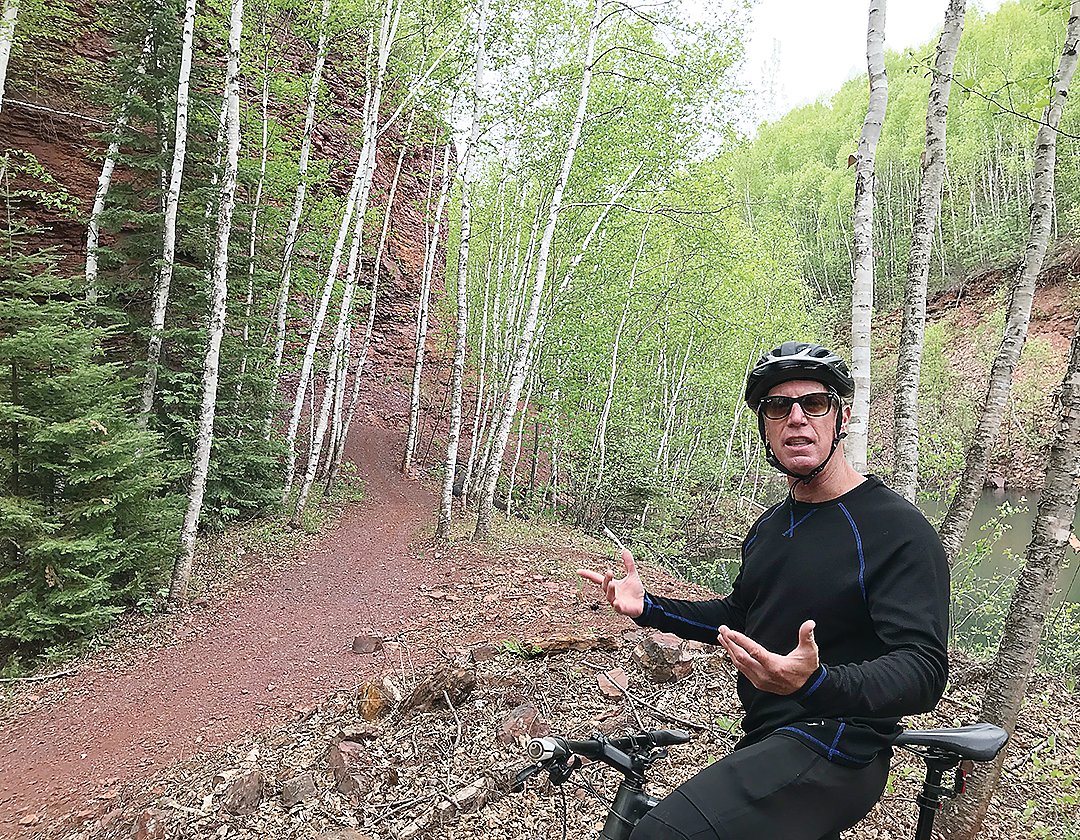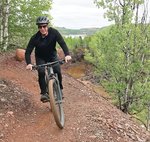Support the Timberjay by making a donation.
Redhead is rad
With focus on quality of life, IRRR is investing big in mountain biking
Jim Plummer now knows what he’s doing after work most days. Plummer, who works for the Department of Iron Range Resources and Rehabilitation’s mineland reclamation division, was among …
This item is available in full to subscribers.
Attention subscribers
To continue reading, you will need to either log in to your subscriber account, or purchase a new subscription.
If you are a current print subscriber, you can set up a free website account and connect your subscription to it by clicking here.
If you are a digital subscriber with an active, online-only subscription then you already have an account here. Just reset your password if you've not yet logged in to your account on this new site.
Otherwise, click here to view your options for subscribing.
Please log in to continue |
Redhead is rad
With focus on quality of life, IRRR is investing big in mountain biking
Jim Plummer now knows what he’s doing after work most days. Plummer, who works for the Department of Iron Range Resources and Rehabilitation’s mineland reclamation division, was among those who helped in the development of the Redhead mountain biking trails at the Minnesota Discovery Center, formerly Ironworld, in Chisholm.
The first phase of trail development, which includes about 15 miles of trail, is all but completed and a soft opening to the public is set for June 12. But Plummer, who is exercising his mountain biking itch these days, has already had a head start exploring the trails. The trailhead is conveniently located barely 100 feet from the door to his IRRRR office, located at the Discovery Center. We should all be so lucky.
Not that he isn’t sharing the wealth. This past week, he led me on a shakedown cruise deep into what is likely to become one of the hottest mountain biking trails in the Midwest once word gets out. And believe me when I tell you, word is going to get out.
As you drop down off the rim and descend into the mine pit, it’s easy to forget you’re anywhere in the Midwest. It’s been called the “Grand Canyon of the North,” and, sure, there’s a bit of hyperbole there, but it gives you an idea that this isn’t going to be like exploring a typical northern Minnesota logging road. The trails, variously designed for all skill levels, twist and turn through numerous switchbacks that wind through open forests of aspen and birch, with frequent stunning views of steep, multi-colored rock walls and crystalline pit lakes.
“It offers the kind of viewsheds you don’t often find in the Midwest,” said Scott Linnenburger, the principal at Boulder-based Kay-Linn Enterprises, the firm that’s building the trail. “It feels much more similar to canyon country or desert areas in Utah or Colorado than to a forested region,” said Linnenburger
Linnenburger’s company has plenty of experience. To date, they’ve built over 600 miles of mountain biking trails, although he said some of the trails built at Chisholm were among the toughest to construct. “We’ve really got some of the best trail builders in the country working on it— and they work in a variety of conditions. They often work on steep slopes, but here it’s always steep.”
Plummer said it was amazing to watch the trail crews at work as they traversed the slopes and loose rock with their equipment, while managing to keep everything upright and ensure that the trails are kept in place. And the trail crews didn’t use brute force as they did their work. Instead, they sculpted the trails into place, like artists using the terrain as their palette. The result is a trail that is both exciting to ride and, at times, gorgeous to view.
Economic revival?
The Redhead project, at a cost of $1.777 million, is just one of three major investments in mountain biking that the IRRR is making in the area. The growing emphasis on mountain biking comes in the wake of the economic revival experienced by the communities of Crosby and Ironton, after the creation of Minnesota’s first state park dedicated to mountain biking on former Cuyuna Range mine spoils. The park has attracted more than 25,000 riders annually to the communities, providing millions of dollars a year in new tourism-related spending. That’s sparked an entrepreneurial revival with 15 new shops and restaurants— along with new residents— since the opening of the park several years ago.
IRRR Commissioner Mark Phillips said he was impressed with the changes that the the Cuyuna trails have brought to Crosby and he hopes to see similar changes in Chisholm. While he had initially looked at a smaller investment in trails, he said the experienced people that IRRR staff consulted said if they wanted world class trails, that would truly attract more than just local riders, it would require a major project that would interest the best trail builders in the business. Between the Redhead trails, the expanding network at Giants Ridge and the Tioga trails near Cohasset, Phillips said the region now has more than enough trails to bring people in for multiple days of riding. Add in new trails in Duluth along with the Cuyuna system and Phillips sees a likely “circle tour” for mountain bikers.
That’s the hope of former Chisholm City Council member Marty Halverson, who was riding the new trails himself last week. The city of Chisholm will have responsibility for maintaining the trails and the city’s liability insurance will cover the associated risks from injuries— two issues that made the trail agreement for the Redhead somewhat controversial in Chisholm. But the small city also stands to be among the biggest beneficiaries of the additional visitation that the trail network— which should be up to 30 miles by the end of the summer— is expected to bring. Halverson said he’s already heard from some local business owners who are planning to revamp their operations to cater to bikers— and he expects to hear a lot more of that in the future. “I think this is just the tip of the iceberg and it’s an awfully big iceberg,” he said.
Linnenburger agrees. He notes that recent outdoor industry surveys put the number of avid mountain bikers at around 10 million in the United States. He says about 20 percent of those riders report taking at least one mountain biking-focused vacation annually. “Most of the avid bikers in the Midwest that I know leave the Midwest when they take that vacation every year. Now, they have someplace that’s a whole lot closer, with some of the best trails in the world.”
While attracting visitors is a major goal of the investment in trails, Phillips sees it as something more. It’s about creating the kind of quality of life in the region that will attract new residents, businesses, and business owners. That’s been a major focus for Phillips, and it’s a tried and true development formula that has created growing and prosperous communities in many rural parts of the country, particularly in the western United States.
The trails are also a good fit with the Minnesota Discovery Center and the adjacent county fairgrounds, says Phillips, because the related infrastructure, including showers, kitchen facilities, a restaurant, and amphitheater would be extremely useful for large group gatherings or biking expos which are likely to come as the site gets known. Bringing large numbers of tourists to the region was the original goal of Ironworld, but Phillips acknowledges that it’s been difficult to attract visitors to the Mesabi Range. “Most of our tourism in the region has been focused in places like Ely or Grand Marais,” said Phillips. “Now we have something that may really start getting tourists to the core Range.”












